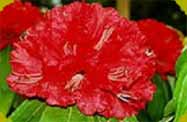|
Dioscorea deltoida
Wall.

|
Species |
Dioscorea deltoida
Wall. |
|
Local Name |
Byakur(Nep), Gebokkanak(Lep) |
|
Synonym |
D. pentaphylla
L. |
|
Family |
Dioscoreaceae |
|
Habitat |
An extensive climber perennial herb. Grows in forests
rich in organic matter of forests of temperate
Himalaya. |
|
Distribution |
Distributed in the alpine and sub- alpine areas. |
|
Sikkim |
Ravong (Hee- Gyathang), Lingthem, Lingdem, Sakyong, Bay,
Busuk forest, Rinchenpong, Kaluk, Lingdong (East
Sikkim), Kabhi, Leek. |
|
Out side |
Distributed in
the alpine zone of Western Himachal Pradesh and Jammu-
Kashmir (Bat kote, Besu, Ferozpur, Dachhigam forest,
Kishanganga valley, Jakhar, Jhelum valley, Srinagar,
Butna valley, Bhadrawah), Himachal Pradesh (Manali,
Saraham, Nichar, Basdpa valley, Kinnaur, Sangla, Lahul,
Simla, Narkunda); UttarPradesh (Mussoorie, Bhyundar
valley, Magra, Deolasari, Glovaona, Tolma, Chamoli,
Jhumnotri, Gangotri, Nandagiri valley, Mundali, Chakrata
forest, Dehradun). |
|
General |
|
|
Morphological |
Perennial,
climbing herb having horizontal rhizome near the surface
chestnut brown outside with rectangular cracks. Stems
unarmed, twinning to the left. Leaves alternate, ovate-
lanceolate. Flowers in spike, male flowers 1- 3 in long
spike female flower 1- 3 in long spike. Female flowers
on pendant spike capsules 4- 6, wings broadly rounded.
Seeds usually winged all round but sometime only one
side light yellowish- brown coloured at maturity. |
|
Flowering |
May-July |
|
Fruiting |
|
|
History |
|
|
Parts |
Tubers. |
|
Status |
Endangered |
|
Phytochemistry |
Trioside and tetraoside (I) of
furostanol type, diosgenin and their acetates isolated
from rhizomes and their structures determined (I ZV.
Akad. Nauk SSST. Ser Khim 1975, 90; Chem. Abstr 1975,
82, 156636 r).
Two new
compounds- 4- hydroxy- 2- (Trans 3', 7 methylocta 2’ 6'
-dienyl)- 6- methoxy- acetophenone (I) and 4, 6-
dihydroxy- 2- O (4- hydroxybutyl) acetophenone (II) -
isolated and characterized ( Phytochemistry 1989, 28,
947). |
|
Agrocultivation |
The
plant can be propagated by seeds, rihizome pieces or
stem cuttings. |
|
Reference |
1. Chopra, R.N;
S.L. Nayar; I.C. Chopra (1999). Glossary of Indian
Medicinal Plants. National Institute of Science
Communication CSIR, New Delhi, 97.
2. Dr. Hussain,
Akhtar (1993). Medicinal Plants and their Cultivation,
CIMAP, Lucknow. 55- 65.
3. Kumar, Sushil;
Janardhan Singh; N.C Shah; Vinay Ranjan (1997). Indian
Medicinal and Aromatic Plants facing Genetic Erosion,
CIMAP, Lucknow. 101- 104.
4. Progress
Report of the Project "Studies on Medicinal Plants of
Sikkim" (1998- 2001). State Council of Science and
Technology for Sikkim.
5. Thakur, R.S.; H.S. Puri; Akhtar Hussain (1989). Major
Medicinal Plants of India, CIMAP, Lucknow. 261- 263. |
|
Medicinal |
Diosgenin a
steroid is considered suitable for the manufacture of
oral contraceptives and the sex hormones.
Certicateroids
in the form of cortisones and hydrocortisone's are used
for the treatment of rheumatism, rheumatic fevers,
arthritis and other collagen disease of skin, eye and
the ear.
Both male and
female sex hormones are synthesized from diosgenin. The
male hormone testosterone and its derivatives are used
to correct the male hormonal deficiency, especially in
certain cases of impotency. These are also used for the
treatment of breast cancer and menopause and various
forms of uterine bleeding. Testosterone is inactive
orally so it is converted into various derivatives. The
main female sex hormones are estrogens and progesterone.
Estrogen is used to suppress symptoms of natural or
surgical menopause, local a tropic changes in the adult
vagina and vulva, gonorrheal vaginitis. It is also used
in cosmetic lotions and creams to improve tone and
colour of the skin in women. Progesterone is mainly used
as antifertility agent in the form of oral
contraceptive. |
|
Ayurvedic |
|
|
Unani |
|
|
Traditional |
|
|
Others |
|
|
Prepartation |
|
|
Picture |
|
|
|
|
|

Rhododendron


Amongst the many
floral treaties of Sikkim Himalaya one of the earliest ones may be
found over the genus Rhododendron (Gk. rhodo = red, dendrons = tree
). |
| |
|
|
|

Orchid


Orchid
known for their brilliance in colors, unusual shapes
attractive growth habits, variety in fragrance and
exquisite beauty can attract any nature lovers.
|
| |
|
|
|

Medicinal Plant


Sikkim
with its total geographical area of 7,096 sq km is
bestowed with a huge diversity of flora and fauna.
|
| |
|
|
|
|
|